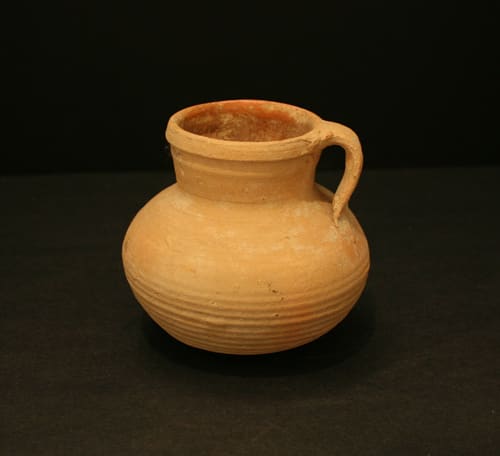Roman Period Terracotta Vessel, 50 BCE - 150 CE
Terracotta
4
SP.253
This Roman two-handled pot comes from En Gedi, an archaeological site steeped in ancient history. En Gedi is an oasis on the western shores of the Dead Sea and is...
This Roman two-handled pot comes from En Gedi, an archaeological site steeped in ancient history. En Gedi is an oasis on the western shores of the Dead Sea and is the name of the perennial spring that flows from a height of 200 meters above the Dead Sea. Biblical references to the site are numerous. In the stories about David’s flight from Saul, the desert area around the spring is called the “Wilderness of En-Gedi.” The site is also mentioned in the Song of Songs in connection with its vineyards. Various references to En-Gedi are also found in later sources from the second temple and the Roman and Byzantine periods. Moreover, documents were discovered in a nearby cave reveal that during the period preceding the second revolt, En-Gedi was a Jewish village that had become the property of the emperor and a Roman garrison was stationed there in the time of Bar Kokhba. The site was one of the administrative and military centers of the Prince of Israel.
Created during the Roman occupation of Israel, this elegant vessel might have held an offering of food or drink, or perhaps served as a drinking vessel for a thirsty carpenter. Or perhaps it held sauces or condiments to delight the palate and spruce up an otherwise humble meal for a shepherd. As we hold it in our hands today, admiring its simple beauty, we are aware of the touch of other hands long ago. Who might have held it when it was new? Were the dreams and emotions that guided their lives so very different from our own? The vessel's graceful unadorned shape appeals as much to the contemporary eye as it did to the culture that created it. Such artifacts, ordinary enough in their own age, connect us in an intimate way with the world of the past. In its presence, we cross the bridge of time and set the imagination on a journey of discovery.
Created during the Roman occupation of Israel, this elegant vessel might have held an offering of food or drink, or perhaps served as a drinking vessel for a thirsty carpenter. Or perhaps it held sauces or condiments to delight the palate and spruce up an otherwise humble meal for a shepherd. As we hold it in our hands today, admiring its simple beauty, we are aware of the touch of other hands long ago. Who might have held it when it was new? Were the dreams and emotions that guided their lives so very different from our own? The vessel's graceful unadorned shape appeals as much to the contemporary eye as it did to the culture that created it. Such artifacts, ordinary enough in their own age, connect us in an intimate way with the world of the past. In its presence, we cross the bridge of time and set the imagination on a journey of discovery.



